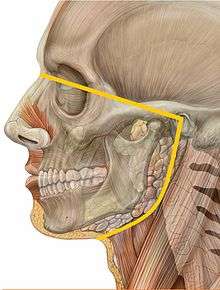Orofacial pain
| Orofacial pain | |
|---|---|
 | |
| Dermatomes of the face. | |
| Classification and external resources | |
| MeSH | D005157 |
Orofacial pain is a general term covering any pain which is felt in the mouth, jaws and the face. Orofacial pain is a common symptom, and there are many causes.[1] It is estimated that over 95% of cases of orofacial pain result from dental causes (i.e. toothache caused by pulpitis or a dental abscess).[2] After dental pain, the second most common cause of orofacial pain is temporomandibular joint dysfunction (TMD, pain-dysfunction syndrome).[3] All other causes of orofacial pain are rare in comparison, although the full differential diagnosis is extensive.
Definition

Orofacial pain has been defined as "pain localized to the region above the neck, in front of the ears and below the orbitomeatal line, as well as pain within the oral cavity; [including] pain of dental origin and temporomandibular disorders".[4] However, some orofacial pain conditions may involve areas outside this region, e.g. temporal pain in TMD. Toothache, or odontalgia, is any pain perceived in the teeth or their supporting structures (i.e. the periodontium). Toothache is therefore a type of orofacial pain. Craniofacial pain is an overlapping topic which includes pain perceived in the head, face, and related structures, sometimes including neck pain.[5]
Classification
There are 4 main classifications which attempt to classify the causes of orofacial pain, but no system is universally accepted.[6]
- The International Classification of Headache Disorders second edition (ICHD-2), a publication by the International Headache Society.[7]
- The Classification of Chronic Pain second edition, a publication by the International Association for the Study of Pain.[8]
- American Academy of Orofacial Pain (AAOP): www.aaop.org.
- The Research Diagnostic Criteria for Temporomandibular Disorders (see temporomandibular joint dysfunction#diagnostic criteria).
It has also been suggested that the most basic etiologic classification of orofacial pain is into the following 3 groups:[9]
- Primarily somatic, arising from musculoskeletal (e.g. TMD pain or periodontal pain) or visceral structures (e.g. pulpal pain or pain from the salivary glands), and transmitted via an intact pain transmission and modulation system.
- Primarily neuropathic, which occurs as a result of abnormal or damaged pain pathways, e.g. a surgical or traumatic injury to a peripheral nerve.
- Primarily psychological, which is rare (See: psychogenic pain).
Epidemiology
Orofacial pain is common problem. For example, in the United States, one report estimated that 22% of the general population had suffered from some form of facial pain at some point in the 6-month period before questioning, of which 12% was toothache.[10] In the United Kingdom, 7% of the general population reported having some degree of chronic orofacial pain.[11] Other reports indicate a prevalence of 10–15% for TMD in the general population.[11]
Differential diagnosis
- Dental causes
- Pulpal
- Pulpitis
- Dentin hypersensitivity
- Cracked tooth syndrome
- Periodontal
- Periapical periodontitis and periapical abscess
- Periodontal abscess
- Pericoronitis and pericoronal abscess
- Pulpal
- Burning mouth syndrome
- Oral ulceration (e.g. aphthous stomatitis, erosive oral lichen planus, etc.)
- Oral cancer
- Persistent idiopathic facial pain (atypical facial pain)
- Atypical odontalgia
- Neuropathic pain
- Trigeminal neuralgia
- Glossopharyngeal neuralgia
- Mental nerve neuralgia
- Headache
- Temporomandibular joint dysfunction (TMD)
- Eagle syndrome
See also
References
- ↑ Martin, WJ; Perez, RS; Tuinzing, DB; Forouzanfar, T (December 2012). "Efficacy of antidepressants on orofacial pain: a systematic review.". International journal of oral and maxillofacial surgery. 41 (12): 1532–9. doi:10.1016/j.ijom.2012.09.001. PMID 23041255.
- ↑ Scully, Crispian (2008). Oral and maxillofacial medicine : the basis of diagnosis and treatment (2nd ed.). Edinburgh: Churchill Livingstone. pp. 98–108. ISBN 9780443068188.
- ↑ Manfredini, D; Guarda-Nardini, L; Winocur, E; Piccotti, F; Ahlberg, J; Lobbezoo, F (October 2011). "Research diagnostic criteria for temporomandibular disorders: a systematic review of axis I epidemiologic findings.". Oral surgery, oral medicine, oral pathology, oral radiology, and endodontics. 112 (4): 453–62. doi:10.1016/j.tripleo.2011.04.021. PMID 21835653.
- ↑ Shephard, Martina K.; MacGregor, E. Anne; Zakrzewska, Joanna M. (December 2013). "Orofacial Pain: A Guide for the Headache Physician". Headache: The Journal of Head and Face Pain. 54 (1): n/a–n/a. doi:10.1111/head.12272. PMID 24261452.
- ↑ Armijo Olivo, S; Magee, DJ; Parfitt, M; Major, P; Thie, NM (Fall 2006). "The association between the cervical spine, the stomatognathic system, and craniofacial pain: a critical review.". Journal of orofacial pain. 20 (4): 271–87. PMID 17190026.
- ↑ Renton, T; Durham, J; Aggarwal, VR (May 2012). "The classification and differential diagnosis of orofacial pain.". Expert Review of Neurotherapeutics. 12 (5): 569–76. doi:10.1586/ern.12.40. PMID 22550985.
- ↑ "2nd Edition of The International Headache Classification". International Headache Society. Retrieved 25 July 2013.
- ↑ "Classification of Chronic Pain" (second ed.). International Association for the Study of Pain. Retrieved 26 July 2013.
- ↑ Hupp JR, Ellis E, Tucker MR (2008). Contemporary oral and maxillofacial surgery (5th ed.). St. Louis, Mo.: Mosby Elsevier. pp. 619–627. ISBN 9780323049030.
- ↑ Hargreaves KM, Cohen S, eds. (2010). Cohen's pathways of the pulp. Berman LH (web editor) (10th ed.). St. Louis, Mo.: Mosby Elsevier. p. 50. ISBN 978-0-323-06489-7.
- 1 2 Zakrzewska, Joanna M (2013). "Multi-dimensionality of chronic pain of the oral cavity and face". The Journal of Headache and Pain. 14 (1): 37. doi:10.1186/1129-2377-14-37. PMID 23617409.